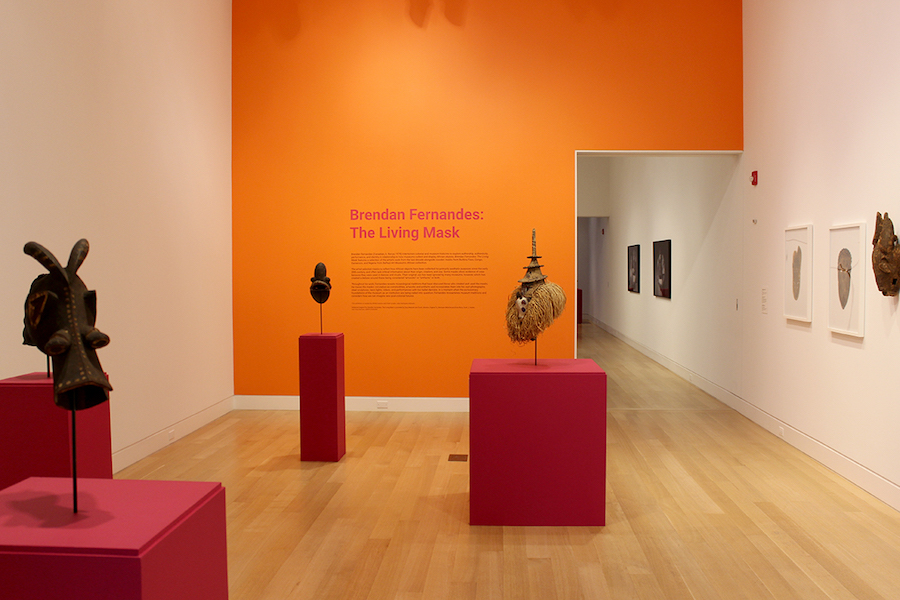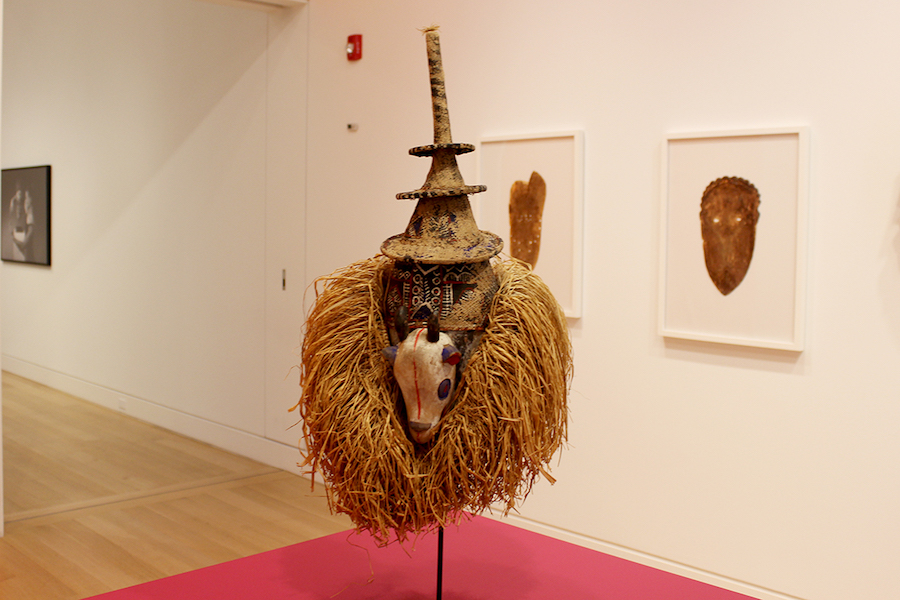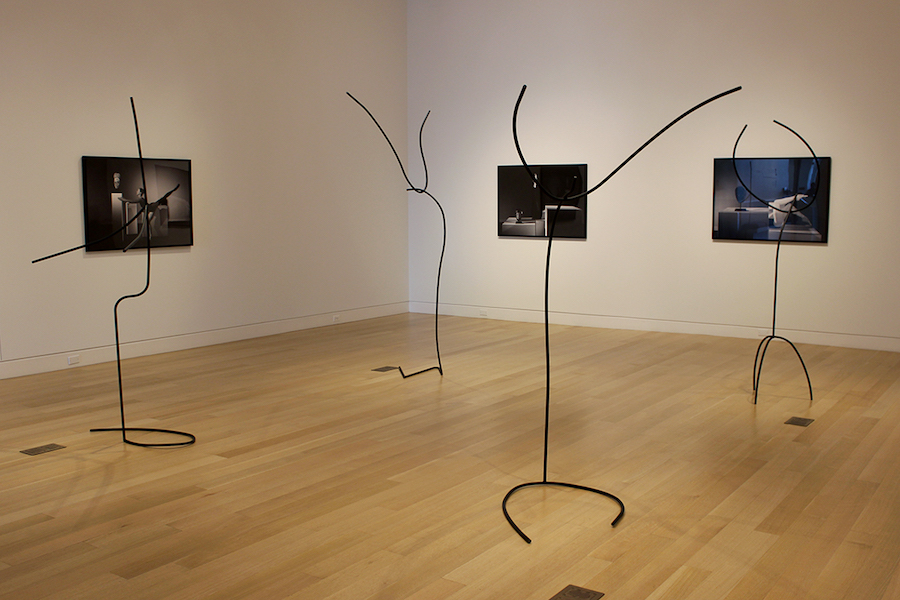Visual artist and dancer Brendan Fernandes recontextualizes museum collections to break down institutional rules. By making histories confront the present day, his diverse body of work invites us to consider how established museum practices might be sidestepped or even altered.
In his solo exhibition The Living Mask at the DePaul Museum of Art, the Kenyan-born artist dissects methods of traditional museum display to bring movement and body to African masks that he pulled from the institution’s collection. Several works of art made over the last eight years — including four large-scale metal armatures inspired by institutional display mounts, a photo series of masks from a New York collection, and a short film produced in the vault of the Justin and Elisabeth Lang Collection of African Art at Queens University — explore the ways museums exhibit and store artifacts. Hung in the front window of the museum are two neon masks. Their flashing light draws you into the first-floor show, as the indecipherable rhythm bestows them with a sense of life.
Recently, I spoke with Fernandes to learn more about his dance background, how African masks are authenticated by museums, and how his personal narrative is woven through what he refers to as his “most traditional” exhibition to date.

For this exhibition, you present viewers with museum-owned African masks. How does your work attempt to return these masks to the body, or provide the objects a bodily presence?
Most of my shows have dancers constantly in them, and this one won’t have that aspect as much. What I am doing in this exhibition is playing with museum display. If you look at all of the masks in Insiders (2017), they are hung at different heights. They are all lined up by eye line. This creates bodying. Instead of thinking about having a body dance, I am thinking about using museum display to counter the etiquette and the rules of how masks are approached.
Typically, everything would be hung at the standard museum height, or if you look at [masks] on plinths, they are always presented straight on. While you are walking through this exhibition, you have to meander to see them all. I wanted this idea that, in the space, you are being taken by all of the masks' eyes. Even through they are inanimate objects, they come from traditions that bring them to life, and so in their staticness they are still given a presence.
How does your work with African masks reflect your personal history?
I use a lot of masks in my work partially because when my family left Kenya, we didn’t have masks or African artifacts in our house. As soon as we were leaving for Canada, we started to buy these objects to almost create mementos for our new home. We had always seen these objects in Kenya, but we acknowledged them as tourist souvenirs or curios. That was one of my first ways of thinking of how we had possibly changed. We had almost become tourists ourselves, as a way to signify “home.”
Eventually, I began to research masks, specifically ones sold on Canal Street in New York City. I began to question the authenticity of the mask object versus the souvenir object that becomes identified as a New York souvenir. It is definitely tied to my cultural narrative — my idea of being Kenyan, Canadian, and Indian, but who now lives in America. I am thinking about how a mask transcends, creates, or hides identity. This object is used to acknowledge tribal rituals and spiritual takeovers — ideas that aren’t seen in a museum collection, or aren’t seen when it is sold as a souvenir. In my work I am searching for this idea of “Who am I?”, but I am being playful. I am not really asking the question, and I am not asking for an answer. I know I am not one thing. It is a constant transformation.
The mask object is also about a transformation because in West African masquerade, where most masks are from, when you put on the mask, your body is taken into a different world. You are not part of this world anymore; you are part of a traditional, cultural “other world.” Your body is taken over. You are not you. But then when you take the mask off, you again become yourself.

Insiders (2017) is a photo series of African masks — this time from the collection of the University at Buffalo Art Galleries — as captured from the inside, as if the viewer is looking out. Although this work references how museums authenticate masks, were you also attempting to transport your viewer with this switched perspective?
A little bit. When I took these images, the masks were all lit from the bottom, almost as if they had a spiritual power. The way we identify a mask is to look inside for body secretions, sweat, and so forth so that those objects can be recognized as being worn. Wearing, engagement, enactment, and performance is a way of authenticating them, because it shows that they have been lived. This is partially what I was thinking about in the series, but I was also thinking about how masks in museum collections are so fickly collected. We don’t know their exact details, and many of them might be fake.
I think museums initially didn't care about those movements or traditions, but we are now coming to a place in museology where we are looking for the return, and seeking the question of what they did before, and that we are not just thinking about them as exotic objects.
How did you further explore that idea with your work Stand Tall (2017), which presents four thin, metal figures paused in what appears to be ballet formations?
These are actually larger versions of the devices that hold masks. The collection I worked with at the University at Buffalo Art Galleries had these metal armatures that were holding the masks, almost like authoritative objects. I thought they were amazing and they looked like little bodies or maquettes, so when I made them large, they took on a bodily presence. I really like that they look like dance positions.

In your exhibition The Master and Form at the Graham Foundation earlier this year, you worked with a group of dancers from the Joffrey Academy of Dance. Although you have a background in ballet, do you typically work with other dancers’ bodies rather than your own?
I have done a few pieces I have included myself in, but for the most part I work with other dancers. It can be very directed, or it can be collaborative and improvised. I will begin to question labor and give the dancers tasks or challenges that they have to figure out. Sometimes I throw these in during the performance, and they can discuss it in front of the audience. They can break out of the perfection. Often I will even make them deal with endurance. Typically when performing, ballet dancers will dance for an hour then they are exhausted and can get off the stage. I will say, “Let's dance for 12 hours.” I want to see how we can use our bodies in different ways.
How did you choose the two dancers for the photographic series As One (2017), which depicts ballet dancers poised with African masks from the University at Buffalo Art Galleries? Did you deliberately cast white bodies as a way to reference ballet’s origin?
For this piece, yes — but for other pieces I work with diverse ballet dancers. Ballet does have a very fraught history of being a white, westernized form of dance, and we are working on changing that. Even as a young boy they would say to me that I would never be in the high ranks of the ballet. I would never be Romeo because Romeo is not a brown character; he is a white man. So we are trying to break down those typically gendered and racialized characters.
This piece is about the postcolonial, and I wanted it to have this tension between [the masks and dancers]. I think in my work I am always thinking about generosity and kindness. For me the confrontation doesn’t need to be aggravating or confrontational. I think we need to think about how we create a social solidarity. Even though the dancers look like they are apologizing in the series, it is not about an apology. It is about an acknowledgement, a coming together, a collaboration. Their bodies become each other. Each photograph becomes strangely hybrid.
There has been a recent movement towards decolonizing museums and their collections. Do you have an opinion or ideal for how that process might be handled?
I think the residue and history of colonization is still relevant. It didn’t happen that long ago [in Africa], so we are still trying to figure it out. Things like artifacts and returning of those artifacts aren’t a priority. I think it is more about the immediate traumas and issues that we are facing within Africa. I don't know if returning the objects is going to do anything for the continent.
I think what is important is to think of where we are now, and then create new conversations and new dialogues. By saying these objects were dance and these objects were performed, to create dialogues that respond to the details that we didn’t know. It is about an acknowledgement and understanding, but then also an education and a communication.
Brendan Fernandes: The Living Mask runs through December 16 at the DePaul Art Museum.


